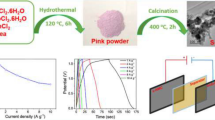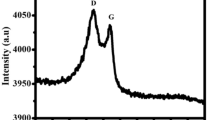Abstract
In the present study, a manganese oxide obtained by the acid treatment of LiMn2O4 spinel has been used as a positive electrode of supercapacitor. Removal of lithium from a spinel allowed to obtain MnO2 compound with the pores partly distributed in atomic scale, hence, an efficient use of its pseudocapacitive properties could be reached. On the other hand, residual lithium remaining in the structure preserved layered framework of MnO2 with pathways for ions sorption. Physical properties, morphology, and specific surface area of electrode materials were studied by scanning and transmission electron microscopy, and nitrogen sorption measurements. Voltammetry cycling, galvanostatic charge/discharge, and impedance spectroscopy measurements performed in two- and three-electrode cells have been applied in order to measure electrochemical parameters. Neutral Li2SO4 aqueous solution has been selected for electrolytic medium. Extension of operating voltage for supercapacitor has been realized through asymmetric configuration with an activated carbon as a negative electrode. The asymmetric capacitor was operating within a voltage range up to 2.5 V (limited to 2.0 V for cycling tests) and was able to deliver a specific capacitance of 60 Fg−1 per capacitor at 100 mA g−1 current density. High specific energy of 36 Wh kg−1 was reached but with a moderate power density.








Similar content being viewed by others
References
Burke A (2000) Ultracapacitors. Why, how and where is the technology. J Power Sources 91:37. doi:10.1016/S0378-7753(00)00485-7
Conway BE (1999) Electrochemical supercapacitors. Kluwer Academic, New York
Raymundo-Pinero E, Khomenko V, Frackowiak E, Béguin F (2005) Performance of manganese oxide/CNTs composites as electrode materials for electrochemical capacitors. J Electrochem Soc 152:A229. doi:10.1149/1.1834913
Khomenko V, Raymundo-Pinero E, Béguin F (2006) Optimisation of an asymmetric oxide/activated carbon capacitor working at 2 V in aqueous medium. J Power Sources 153:183. doi:10.1016/j.jpowsour.2005.03.210
Jurewicz K, Frackowiak E, Béguin F (2004) Towards the mechanism of electrochemical hydrogen storage in nanostructured carbon materials. Appl Phys A 78:981. doi:10.1007/s00339-003-2418-8
Béguin F, Friebe M, Jurewicz K, Vix-Guterl C, Dentzer J, Fracowiak E (2006) State of hydrogen electrochemically stored using nanoporous carbons as negative electrode materials in an aqueous medium. Carbon 44:2392. doi:10.1016/j.carbon.2006.05.025
Cottineau T, Toupin M, Delahaye T, Brousse T, Bélanger D (2006) Nanostructured transition metal oxides for aqueous hybrid electrochemical supercapacitors. Appl Phys A 82:599. doi:10.1007/s00339-005-3401-3
Huwe H, Fröba M (2007) Synthesis and characterization of transition metal and metal oxide nanoparticles inside mesoporous carbon CMK-3. Carbon 45:304. doi:10.1016/j.carbon.2006.09.021
Zhu S, Zhou H, Hibino M, Honma I, Ichihara M (2005) Synthesis of MnO2 nanoparticles confined in ordered mesoporous carbon using sonochemical method. Adv Funct Mater 15:381. doi:10.1002/adfm.200400222
Du Pasquier A, Plitz I, Gural J, Menocal S, Amatucci G (2003) Characteristics and performacne of 500F asymmetric supercapacitor prototypes. J Power Sources 113:62. doi:10.1016/S0378-7753(02)00491-3
Du Pasquier A, Laforgue A, Simon P (2004) Li4Ti5O12/poly(methyl) thiophene assymetric hybrid electrochemical device. J Power Sources 125:95. doi:10.1016/j.jpowsour.2003.07.015
Wang Y, Xia Y (2005) A new concept hybrid electrochemical supercapacitor: carbon/LiMn2O4 aqueous system. Electrochem Commun 7:1138. doi:10.1016/j.elecom.2005.08.017
Hunter JC (1981) Preparation of a new crystal form of manganese dioxide: λ-MnO2. J Solid State Chem 39:142. doi:10.1016/0022-4596(81)90323-6
Ammundsen B, Aitchison PB, Burns GR, Jones DJ, Rozière J (1997) Proton insertion and lithium-proton exchange in spinel lithium manganates. Solid State Ion 97:269. doi:10.1016/S0167-2738(97)00065-9
Goodenough B, Manthiram A, Wnetrzewski B (1993) Electrodes for lithium batteries. J Power Sources 43:269. doi:10.1016/0378-7753(93)80124-8
Du Pasquier A, Blyr A, Courjal P, Larcher D, Amatucci G, Gérand B, Tarascon JM (1999) Mechanism for limited 55°C storage performance of Li1.05Mn1.95O4 electrodes. J Electrochem Soc 146:428. doi:10.1149/1.1391625
Acknowledgements
The authors greatly acknowledge the financial support of the Ministry of Science and Higher Education (Poland) grant COST 31-1199/2007.
Author information
Authors and Affiliations
Corresponding author
Rights and permissions
About this article
Cite this article
Malak, A., Fic, K., Lota, G. et al. Hybrid materials for supercapacitor application. J Solid State Electrochem 14, 811–816 (2010). https://doi.org/10.1007/s10008-009-0856-8
Received:
Accepted:
Published:
Issue Date:
DOI: https://doi.org/10.1007/s10008-009-0856-8




